Piniavos
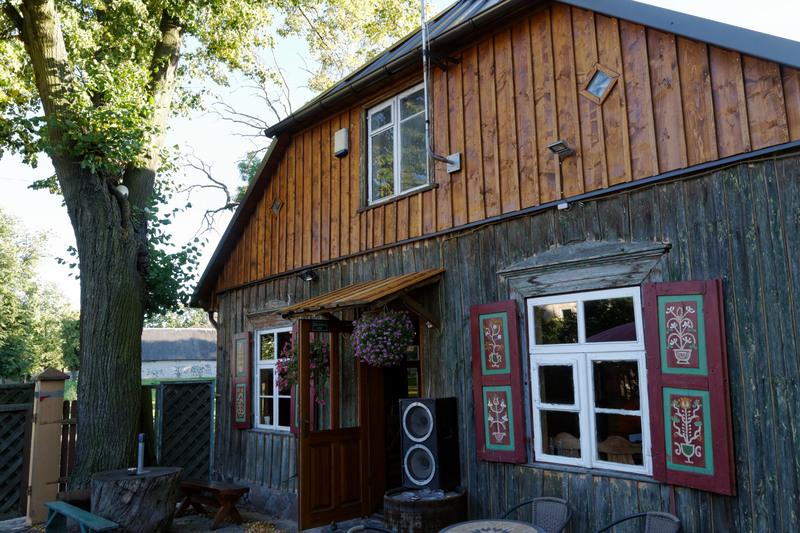
Prie Uosio, the Piniavos brewery tap in Panevežys |
Vidmantas stops the car outside a nondescript gate bearing a small faded sign with the single word "Alutis." It means beer, but with an affectionate diminutive ending. "Alutis," echoes Vidmantas with a satisfied sigh. I assume he's thinking of his online moniker, "Vidma Alutis." Beyond the gate a fierce growling and barking breaks out. Vidma tells me all Lithuanian farmers kept dogs, to guard against strangers and intruders. (This is part 2 of the Lithuanian brewery tour 2015. Yeah, I'm a year behind. Sorry.)
The gate opens, and the dogs all turn out to be chained somewhere out of sight. The brewery has the normal layout for a Lithuanian farmhouse brewery: a square yard, with a brick family home on one side, and a brick brewery on the other side. Because this really is a family brewery, as a true farmhouse brewery should be. The farmhouse tradition, after all, runs in the family, as it always has.
We're met by the brewer, Vidmantas Perevičius, and I recognize him immediately from pictures. I've been a fan of his unusual brewery for many years, so this is a big moment for me, to finally get to see the brewery, talk to the brewer, and try to understand what it is they do, and why.
His family turns out to come from the Kupiškis area. Theoretically, that should make him a keptinis brewer, but he says they're from so close to Biržai that they were outside the keptinis area. He learned to brew from his mother's uncle, and says he's still brewing according to the family tradition. The brewery started in 1989, near the end of the Soviet period, and originally they were brewing in wooden vessels. He's still got the original wooden vessels, and sometimes uses them to show traditional brewing to school classes and so on. He's also got a traditional hand quern for milling the malts. He says it's a hundred times better than modern mills, but he can't use it at the scale he's brewing now. No wonder. I'm told using hand querns is very hard work.
Originally, he made the malts himself, too. He would soak the grain in a sack in the river, then spread it out on cloth or plastic to sprout, and finally dry it in the sun.
So this really was a farmhouse brewery. It would have looked exactly like the photos in old ethnographical papers about Lithuanian farmhouse brewing. Let's compare that with where they are now.
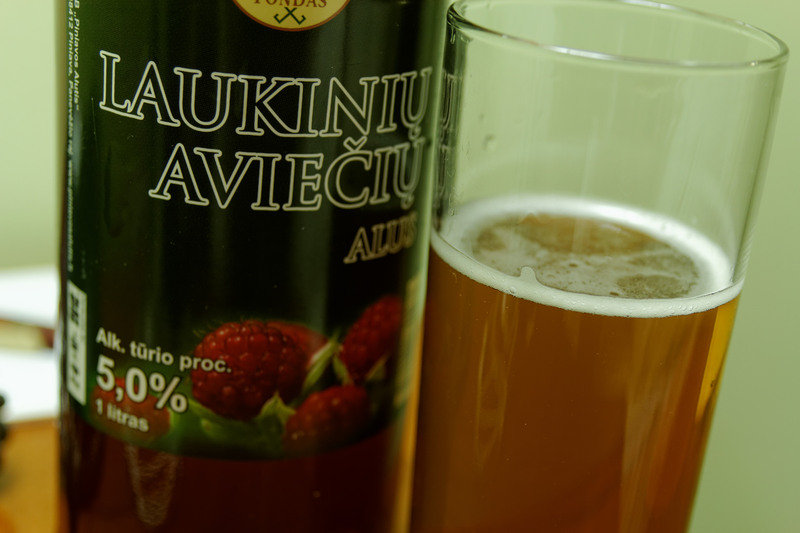
Laukiniu Avieciu |
As with any real farmhouse brewery they don't make many different beers. In fact, only three:
- Seklyčios
- A classic Lithuanian farmhouse ale. A clean, cloudy, refreshing beer that can be drunk by the bucket. Fresh it's a real marvel of a beer, with flavours that would be deeply unusual outside Lithuania.
- Laukiniu Aviečiu
- A darker beer brewed with raspberry stems. More bitter and astringent, with some odd flavours that must come from the raspberry stems. I've puzzled over this beer. Why raspberry stems? It's such an unusual ingredient. Raspberries, sure. But why the stems? I've never heard of that from anywhere else, ever.
- Raudonuju Dobilu
- This one is similar to the Laukiniu, but it uses red clover blossoms. That makes a bit more sense, but it's still unusual.
Vidmantas shows us around the brewery. First the actual brewing room, where there are two big steel containers, and a small one in the back. Note what's not here. There's no copper. That's because they never boil the wort. This is a raw ale brewery, because real Lithuanian farmhouse ale is always raw ale (or maybe just nearly always, I'm not sure).
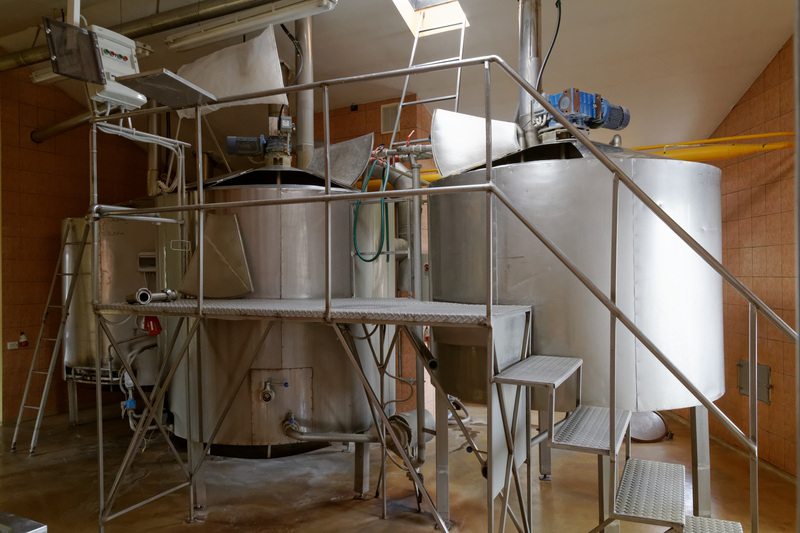
The brewkit |
I ask Vidmantas the function of each vessel, and he points: on the right is the mash tun, and to the left is the strainer (lautering tun). What about the small one in the back? That's the hop tea cooker, Vidmantas says. The hop tea cooker? I knew raw ale brewers would boil hop tea on the side and add it to the wort before fermentation in order to get isomerized alpha acid as protection against bacteria, but I'd never seen a specialized cooker for it.
So where did you get this brewing gear, I ask. I mean, surely you can't buy a hop tea cooker anywhere? As far as I know, no other brewery on the planet has one. Vidmantas smiles and says "local masters came here and welded everything. We made drawings, and they built it for us." So the brewery is actually custom-built to reproduce the farmhouse brewing process.
That insight gives me another idea: so what's with the raspberry stems in the beer, I ask. Vidmantas explains that in the old days, when they brewed in wood, it was tradition in his family to lay raspberry stems on the bottom of the strainer to act as a filter. A light bulb didn't appear over my head, but it certainly felt as if one did. There is the answer to the raspberry stem riddle. Of course!
The strainer is the perhaps most classic farmhouse brewing kit of all: a primitive lautering tun with a filter made out of whatever natural material was to hand. Norwegian brewers use juniper branches as a filter today (example). Finns, Swedes, Danes (example), Estonians, and Latvians (example) sometimes do the same. Earlier people also used alder sticks or straw. Of course that's why they used the stems of the raspberry, rather than leaves or berries. It was at least as much for filtering as for the flavour!
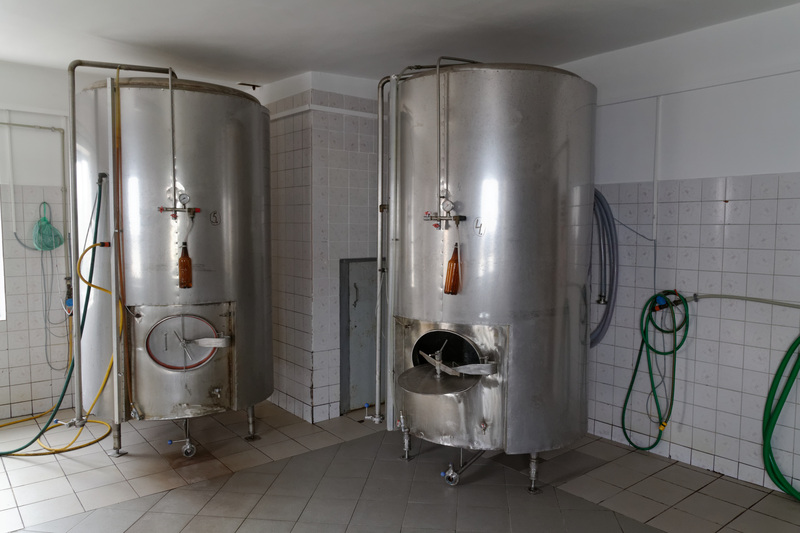
The fermenters |
Suddenly, this strange brewery starts to make sense to me. They've basically taken the traditional brewing process and custom-built steel brewing gear to be able to scale it up. Now they can brew 2000 liters per batch, instead of the 150-200 they would have done originally. But the heart of the brewery remains very much the same. It's still a farmhouse brewery, even if the wood has been replaced by steel.
We leave the brewery to go into the office, where we sit down on couches, and Vidmantas brings out some beer in a traditional ceramic pitcher. Being as fresh as could be it's obviously outstanding. I ask him about shelf-life and he says their beer is good for 20 days. The short shelf-life is probably due in part to the cooling chain not being 100% reliable here in Lithuania.
I start quizzing him about brewing process, and eventually draw a diagram of the process in my notebook to verify that I got it right. Vidmantas mashes by pouring hot water onto the malts at 75C. I think he said the mash was at 75C, but Simonas Gutautas insists the water must have been 75C. So now I'm not sure. Either way, he runs off one wort from that. Then, he adds water again (this time the temperature of something is 82C) and runs off a second wort. Finally, he mixes the two worts together with the hop tea. His term for hop tea is "apyny arbata," which literally translates to "hop tea". I don't manage to grasp why, but he clearly has strong beliefs about not mixing the two worts before the end.
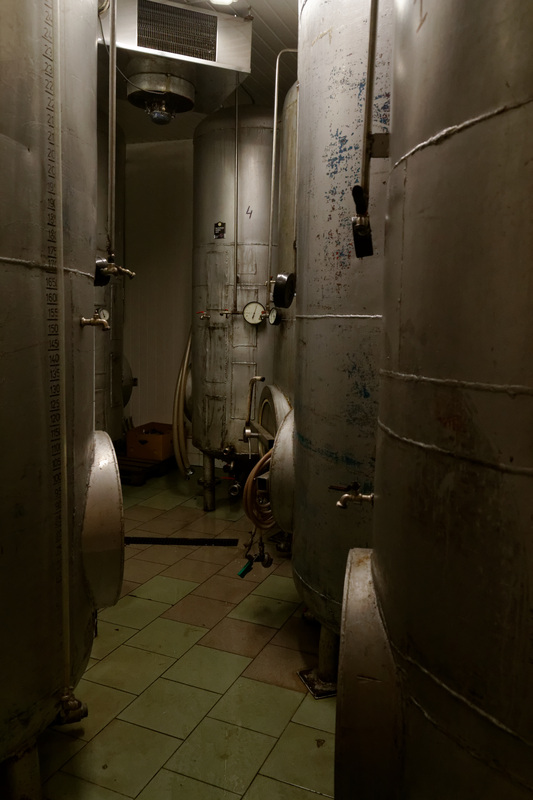
Maturation tanks |
Of course, originally his family mashed without a thermometer, so to find out what temperatures to use he did it the traditional way, but used a thermometer to learn the correct temperature. So in a way he's reverse-engineered his own brewing process. He does add that any temperature in the 70s will work. From my own experience as well as theoretical work I've seen that might well be true.
I ask him what yeast he uses, and it turns out they had their own family yeast (basically kveik), but it went bad, and so now they use lab yeast. You see how close to the brink these ancient brewing strains are. Once the brewery gets infection problems chances are a chunk of world brewing heritage will literally go down the drain. Something really ought to be done to preserve these Lithuanian yeasts, but it's not going to be easy.
I really, badly, want to stay here and ask Vidmantas more questions, and not least, drink more of his excellent beer, but it's getting on for 4 o'clock in the afternoon, and there are many more breweries to visit. So, reluctantly, we take our leave, head back to the car, and drive off. The next brewery is about 10 minutes away.
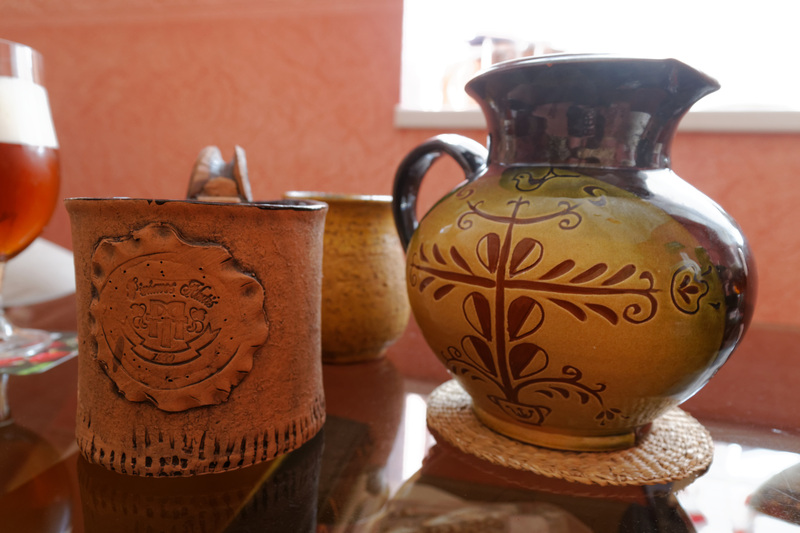
Traditional mug and jug |
Similar posts
Vilnius: a beer guide for the impatient
My guidebook to Lithuanian beer has all the detailed information, but for those who are going to Vilnius and don't want to read 100 pages of detailed text, there isn't anything available now
Read | 2015-03-04 15:26
Jovaru Alus
As a favour to me Vidmantas had left the most interesting brewery as the last of the day, so that we could spend more time there
Read | 2016-08-21 14:14
Comments
Dan Pixley - 2016-06-13 01:59:12
Fantastic article! A metaphorical light bulb went off for me when you described the hop tea. After making my own purposefully soured raw ale, I couldn't figure out how to add my hops (I don't have access to the right species of juniper, and I need hops to combat the sourness of my culture). I mash hopped, which I think stripped most of the character of the hops from my wort. I will try the hop tea next time. Do you have any details on the process of how the hop tea is made? For example, I imagine that the amount of water used has to be kept to a minimum in order to avoid watering down the wort? How long do they boil the hop tea? How do they filter the hops traditionally? Thanks!
Lars Marius Garshol - 2016-06-13 02:16:52
Hi Dan, Hop tea is made simply by boiling hops on the side in a smaller pot, usually for about an hour. Farmhouse brewers typically make ~150 liters of beer, so a liter or two of hop tea doesn't make a big difference, but, yes, the hop tea vessels are smaller. Many Danish brewers say they would add hop tea "to taste".
In Denmark the usual way to filter the hop tea was to pour it through the strainer before adding the malts. That had the additional benefit of extra sanitation of the strainer, plus the spent hops were used in mash hopping, too. Today people may use a simple cloth filter: http://www.garshol.priv.no/tmphoto/photo.jsp?id=t312145 In the old days those might be made of cane or cow hair.
Note that if you don't want to add water to the wort, another option is the Norwegian "humlebeit", which is to boil the hops in a small volume of wort. Something like 5-10% of the total wort.